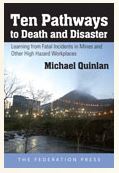How language can change in only a little time! Earlier this month, SafetyAtWorkBlog wrote on the OHS context of the departure of Orica’s CEO, Ian Smith. In a liftout (not available online) in the Australian Financial Review, many of the same questions were asked by its Chanticleer columnist, Tony Boyd. The issues raised by the poor decisions of the board are a useful reminder of one of the potential contributory factors for the occupational and mental health of employees.
At last, one writer in the business press is describing Smith’s behaviour as it was – “…aggressive verbal, foul-mouthed abuse” when Smith “blew his top” and “humiliated” an employee.
This is much more direct language than that used in earlier media reporting where the carefully selected language of corporate media releases was reiterated. To understand the seriousness of the issue, it is necessary to describe actions accurately.
Boyd asked
“…why a 21st-century board of directors would deliberately seek a CEO with an “aggressive management style”.



 SafetyAtWorkBlog has
SafetyAtWorkBlog has